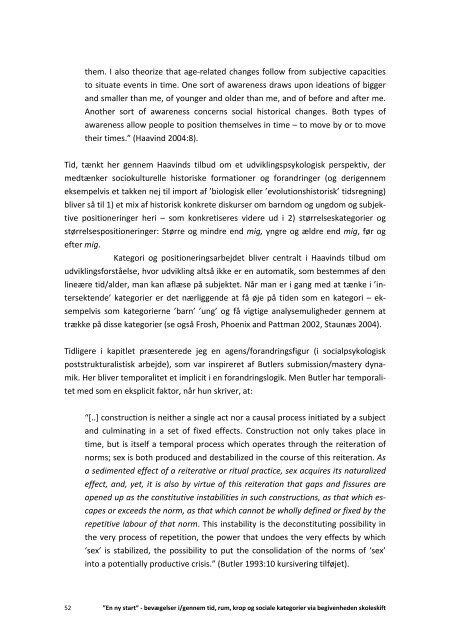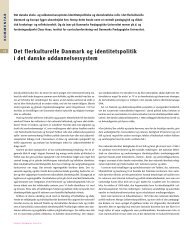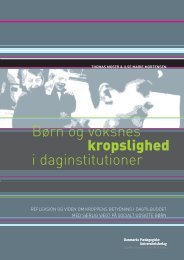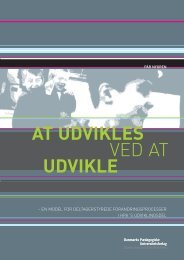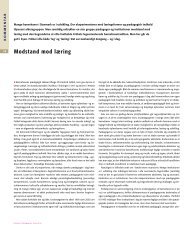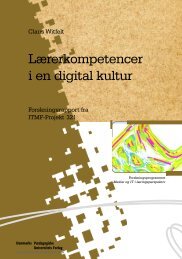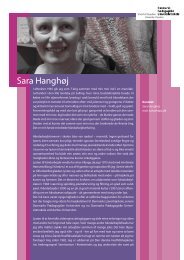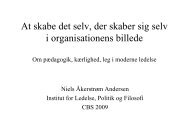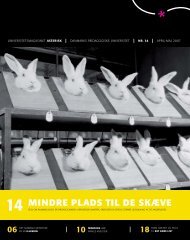EN NY START - DPU
EN NY START - DPU
EN NY START - DPU
You also want an ePaper? Increase the reach of your titles
YUMPU automatically turns print PDFs into web optimized ePapers that Google loves.
52<br />
them. I also theorize that age‐related changes follow from subjective capacities<br />
to situate events in time. One sort of awareness draws upon ideations of bigger<br />
and smaller than me, of younger and older than me, and of before and after me.<br />
Another sort of awareness concerns social historical changes. Both types of<br />
awareness allow people to position themselves in time – to move by or to move<br />
their times.” (Haavind 2004:8).<br />
Tid, tænkt her gennem Haavinds tilbud om et udviklingspsykologisk perspektiv, der<br />
medtænker sociokulturelle historiske formationer og forandringer (og derigennem<br />
eksempelvis et takken nej til import af ’biologisk eller ’evolutionshistorisk’ tidsregning)<br />
bliver så til 1) et mix af historisk konkrete diskurser om barndom og ungdom og subjek‐<br />
tive positioneringer heri – som konkretiseres videre ud i 2) størrelseskategorier og<br />
størrelsespositioneringer: Større og mindre end mig, yngre og ældre end mig, før og<br />
efter mig.<br />
Kategori og positioneringsarbejdet bliver centralt i Haavinds tilbud om<br />
udviklingsforståelse, hvor udvikling altså ikke er en automatik, som bestemmes af den<br />
lineære tid/alder, man kan aflæse på subjektet. Når man er i gang med at tænke i ’in‐<br />
tersektende’ kategorier er det nærliggende at få øje på tiden som en kategori – ek‐<br />
sempelvis som kategorierne ’barn’ ’ung’ og få vigtige analysemuligheder gennem at<br />
trække på disse kategorier (se også Frosh, Phoenix and Pattman 2002, Staunæs 2004).<br />
Tidligere i kapitlet præsenterede jeg en agens/forandringsfigur (i socialpsykologisk<br />
poststrukturalistisk arbejde), som var inspireret af Butlers submission/mastery dyna‐<br />
mik. Her bliver temporalitet et implicit i en forandringslogik. Men Butler har temporali‐<br />
tet med som en eksplicit faktor, når hun skriver, at:<br />
“[..] construction is neither a single act nor a causal process initiated by a subject<br />
and culminating in a set of fixed effects. Construction not only takes place in<br />
time, but is itself a temporal process which operates through the reiteration of<br />
norms; sex is both produced and destabilized in the course of this reiteration. As<br />
a sedimented effect of a reiterative or ritual practice, sex acquires its naturalized<br />
effect, and, yet, it is also by virtue of this reiteration that gaps and fissures are<br />
opened up as the constitutive instabilities in such constructions, as that which es‐<br />
capes or exceeds the norm, as that which cannot be wholly defined or fixed by the<br />
repetitive labour of that norm. This instability is the deconstituting possibility in<br />
the very process of repetition, the power that undoes the very effects by which<br />
‘sex’ is stabilized, the possibility to put the consolidation of the norms of ‘sex’<br />
into a potentially productive crisis.” (Butler 1993:10 kursivering tilføjet).<br />
”En ny start” ‐ bevægelser i/gennem tid, rum, krop og sociale kategorier via begivenheden skoleskift


